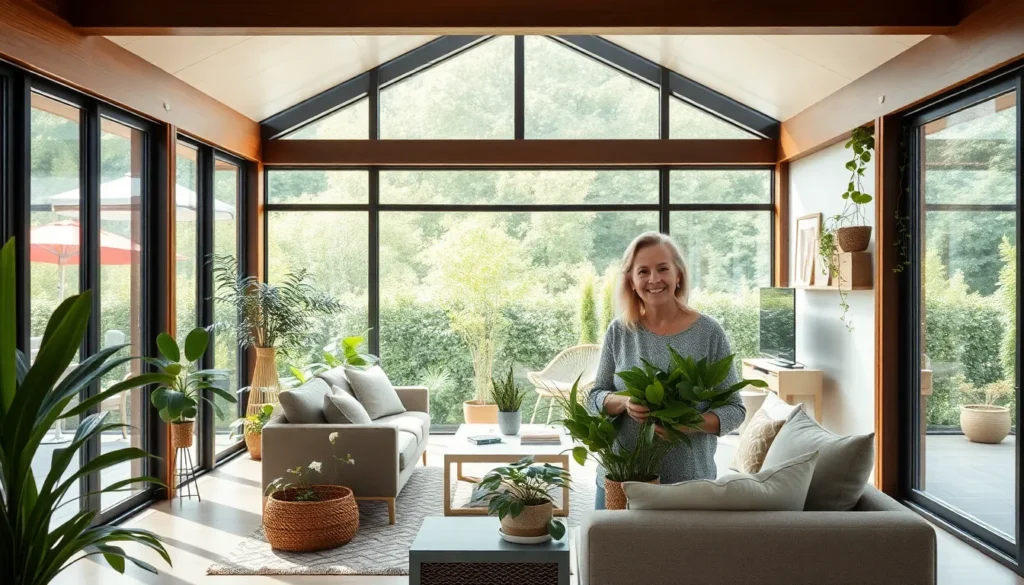Table of Contents
ToggleIn today’s fast-paced world, efficient home design has become more important than ever. Homeowners are seeking ways to maximize space, reduce energy consumption, and create a harmonious living environment. This trend isn’t just about aesthetics; it’s about functionality and sustainability, ensuring that homes not only look good but also serve their inhabitants well.
From open floor plans that enhance flow to smart technology that optimizes energy use, innovative design solutions are transforming how people live. As the demand for efficiency grows, understanding the principles of effective home design can lead to a more comfortable and eco-friendly lifestyle. Whether building from scratch or renovating, embracing these concepts can make a significant difference in both daily life and long-term savings.
Understanding Efficient Home Design
Efficient home design integrates functionality, comfort, and sustainability. It focuses on optimizing space and resources to create harmonious living environments.
What Is Efficient Home Design?
Efficient home design emphasizes maximizing space utilization and minimizing waste. Concepts such as open floor plans create fluid transitions between areas, enhancing both functionality and aesthetics. Energy-efficient materials, natural lighting, and smart technology components play significant roles in maximizing a home’s performance. Design elements prioritize user experience, ensuring spaces cater to various needs without compromising comfort.
Importance of Efficient Home Design
Efficient home design significantly impacts energy consumption and costs. Homes designed with energy-saving fixtures can reduce utility bills by up to 30%. Effective layouts contribute to improved air quality, increased natural light, and reduced environmental footprint. The integration of smart technology allows homeowners to monitor and control energy usage efficiently. Sustainable homes support healthier living by providing comfortable spaces while minimizing waste, ultimately aligning with modern values of eco-friendliness and long-term savings.
Key Principles of Efficient Home Design

Efficient home design hinges on principles that enhance functionality and sustainability. Key areas include space optimization, energy efficiency, and the use of sustainable materials.
Space Optimization
Maximizing usable space facilitates comfort and organization. Open floor plans eliminate unnecessary barriers, creating a sense of spaciousness. Multi-functional furniture allows for diverse uses, such as beds with built-in storage or foldable tables. Additionally, strategic placement of windows ensures natural light penetrates all areas, enhancing the overall aesthetic while reducing reliance on artificial lighting.
Energy Efficiency
Incorporating energy-efficient solutions leads to notable cost savings. Energy-efficient appliances can reduce energy consumption by up to 50% compared to standard models. Using LED lighting instead of incandescent bulbs lowers electricity usage significantly. Proper insulation and energy-efficient windows minimize heat loss, keeping homes warmer in winter and cooler in summer. Smart home technologies, like programmable thermostats, enable precise control over heating and cooling, further optimizing energy use.
Sustainable Materials
Choosing sustainable materials supports eco-friendly practices. Recycled and reclaimed materials reduce waste and promote a circular economy. Bamboo and cork are renewable resources that provide durable flooring options. Non-toxic paints and finishes enhance indoor air quality while minimizing environmental impact. Integrating these materials creates a healthier living environment, aligning with sustainable values and promoting long-term ecological benefits.
Benefits of Efficient Home Design
Efficient home design offers numerous advantages that contribute to improved living experiences. These benefits encompass increased comfort, cost savings, and a positive environmental impact.
Increased Comfort
Increased comfort results from efficient home design principles. Optimized space plans promote an open layout, allowing natural light to flood interiors. Enhanced airflow improves air quality and reduces humidity levels. Multi-functional furniture caters to various needs, allowing families to utilize their spaces effectively. Efficient design also considers temperature regulation through proper insulation, enhancing overall comfort throughout all seasons.
Cost Savings
Cost savings significantly impact households when implementing efficient home design. Energy-efficient appliances consume less power, resulting in reduced utility bills. Proper insulation minimizes energy loss, allowing homeowners to rely less on heating and cooling systems. Over time, these savings can accumulate, with estimates suggesting households reduce expenses by up to 30%. Water-saving fixtures also lower water bills, promoting responsible resource usage.
Environmental Impact
Environmental impact forms a crucial aspect of efficient home design. Utilizing sustainable materials, such as recycled products and eco-friendly finishes, minimizes the ecological footprint during construction and renovation. Energy-efficient designs contribute to lower greenhouse gas emissions by decreasing energy consumption. Incorporating smart technology allows for better energy monitoring and waste reduction. Collectively, these sustainable practices foster healthier environments for both residents and the planet.
Challenges in Implementing Efficient Home Design
Efficient home design faces several challenges that can hinder its successful implementation, particularly concerning budget and design limitations.
Budget Constraints
Budget constraints often limit the ability to implement efficient home design strategies. Homeowners frequently encounter challenges when trying to incorporate energy-efficient appliances, smart technology, and sustainable materials. For instance, high-quality energy-efficient windows can exceed the budget by 10-15%, while eco-friendly building materials often come with a premium cost. Additionally, installing renewable energy sources, such as solar panels, can require significant upfront investment, despite offering long-term savings. Homeowners might prioritize immediate needs over sustainable options when operating within a tight budget, leading to compromises on efficiency.
Design Limitations
Design limitations further complicate the implementation of efficient home design. Building codes and zoning regulations can restrict innovative layouts and the integration of energy-efficient solutions. For example, existing homes may have structural issues that prevent desirable renovations, such as open floor plans or enhanced insulation techniques. Furthermore, some properties may lack adequate natural light, making it challenging to maximize energy efficiency without significant alterations. These constraints can result in missed opportunities for integrating modern efficiencies, ultimately impacting the overall effectiveness of the home’s design.
Efficient home design represents a vital shift towards creating spaces that prioritize comfort and sustainability. By embracing innovative solutions and smart technology, homeowners can enjoy enhanced living experiences while reducing their environmental footprint. The principles of space optimization and energy efficiency not only lead to significant cost savings but also contribute to healthier indoor environments.
Despite challenges like budget constraints and design limitations, the long-term benefits of efficient home design far outweigh the initial hurdles. With careful planning and a focus on sustainable materials, anyone can transform their home into an efficient haven that aligns with modern values. This commitment to thoughtful design ultimately fosters a better quality of life for both residents and the planet.




